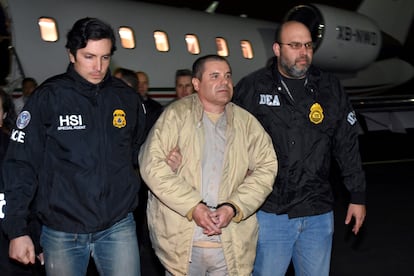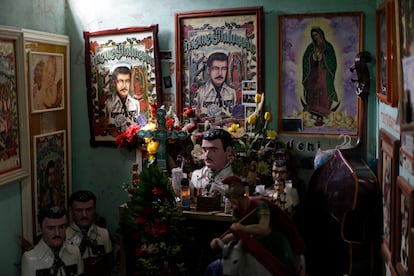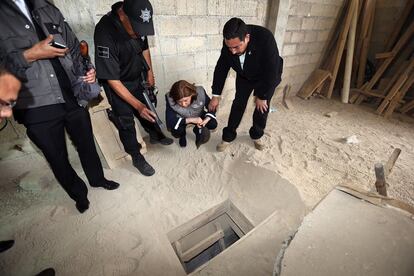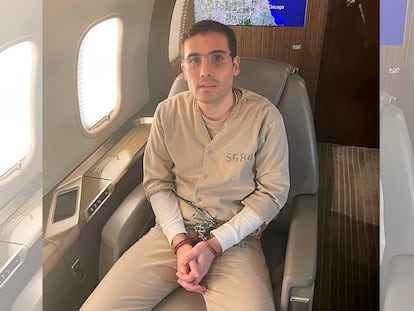Joaquín ‘El Chapo’ Guzmán: What you need to know about the Mexican drug kingpin
Involved in the drug business since he was a teenager, Guzmán became one of the most well-known drug lords in the world. Now, he’s serving a life sentence in a Colorado prison

Joaquín Guzmán, nicknamed “El Chapo” (Mexican slang for “shorty”) due to his short stature and stocky physique, is undeniably one of the most notorious criminals of the 21st century. His prison escapes, the vast and powerful criminal empire he led, and his ability to evade law enforcement for extended periods have elevated him to legendary status in the world of organized crime. His notoriety transcended criminal circles, making him a household name and a subject of fascination for many.
Guzmán’s capture and subsequent extradition to the United States marked a significant milestone in the fight against drug cartels and organized crime in Mexico. His high-profile trial in the U.S. in 2019 shed light on the inner workings of his criminal enterprise and the far-reaching influence he had on both sides of the U.S.-Mexico border. Currently, the former drug lord is serving a life sentence in prison. Nevertheless, the U.S. and Mexican governments continue to grapple with the aftermath of his drug empire.
Who is ‘El Chapo’?
Joaquín “El Chapo” Guzmán is a former Mexican leader within the Sinaloa Cartel, an international crime organization, and he is considered one of the most powerful drug traffickers in history globally. He entered the drug trade through his father’s involvement in growing marijuana for local dealers. In the 1970s, he collaborated with Héctor Luiz Palma Salazar, a rising Mexican drug lord, before joining Miguel Ángel Félix Gallardo, the founder of the Guadalajara Cartel.
After Félix’s arrest in 1988, Guzmán formed his own cartel with Palma Salazar, the Sinaloa Cartel. As a result of changes within the supply lines used by Colombian drug organizations, Guzmán’s operations expanded, bringing him immense wealth and power throughout Mexico, the United States, and Europe. He oversaw the production and distribution of various drugs, including cocaine, methamphetamine, marijuana, and heroin. Guzmán is renowned for pioneering the use of distribution cells and long-range tunnels near borders, which facilitated the Cartel’s exportation of drugs to the U.S. more than any other trafficker in history.

Guzmán has been arrested three times, with two successful escapes. His first arrest occurred in 1993 in Guatemala, leading to extradition to Mexico and a 20-year prison sentence for drug trafficking and the murder of a cardinal during an attack in Guadalajara. He escaped in 2001 after bribing prison guards who facilitated his getaway, prompting the U.S. and Mexican governments to offer an $8.8 million reward for information leading to his recapture.
His second arrest transpired in Mexico in 2010, but he escaped before formal sentencing in 2015 through a tunnel dug by associates into his jail cell. He was recaptured following a shootout in January 2016 and subsequently extradited to the U.S. In 2019, he was found guilty of multiple criminal charges related to his role in the Sinaloa Cartel and sentenced to life imprisonment. He is currently incarcerated in the United States Penitentiary, Administrative Maximum Facility (ADX Florence) in Florence, Colorado. However, the Sinaloa Cartel is still active.
How did ‘El Chapo’ gained power?
Joaquín “El Chapo” Guzmán’s ascent to power resulted from a combination of factors, including his strategic leadership within the Sinaloa Cartel, his ruthless tactics, and the dynamics of the drug trade in Mexico. He initiated his criminal career with the Guadalajara Cartel, and after the group’s decline in the late 1980s, which provided him access to an established criminal organization, he founded the Sinaloa Cartel.
El Chapo’s rise can be attributed to his strategic thinking and leadership, enabling him to organize and execute intricate drug trafficking operations, often employing sophisticated methods like tunnels and submarines. His readiness to employ violence and extreme measures to eliminate rivals or threats also bolstered his reputation within the criminal world.

Guzmán’s involvement in corruption and bribery schemes infiltrated law enforcement agencies and co-opted government officials, granting him a level of impunity. His control over critical drug trafficking routes, especially along the U.S.-Mexico border, allowed him to amass wealth and influence, giving him significant leverage over other drug traffickers and criminal groups.
Despite his criminal activities, “El Chapo” demonstrated a sharp business acumen, understanding the economics of the drug trade, including supply and demand dynamics. His charismatic and enigmatic persona contributed to his notoriety, making him somewhat of a folk hero in certain Mexican communities, which complicated law enforcement efforts to apprehend him.
Guzmán’s prison escapes
“El Chapo” Guzmán escaped from prison twice in Mexico. The first escape occurred in 2001, following a Supreme Court of Mexico ruling that simplified the extradition process between Mexico and the United States. Guzmán orchestrated his getaway with the assistance of bribed prison guards, notably in January 2001. A prison guard named Francisco “El Chito” Camberos Rivera opened Guzmán’s electronically operated cell door, and he concealed himself inside a laundry cart pushed by maintenance worker Javier Camberos, eventually exiting the prison. Guzmán disappeared into the night, and the escape plan involved 78 individuals. Camberos was subsequently imprisoned for his role in the escape.
The second escape took place on July 11, 2015, when Guzmán vanished through an underground tunnel stretching 1.5 km (0.93 mi) to a construction site in the Santa Juanita neighborhood. This impressive engineering feat was dug 33 feet below the ground, equipped with artificial lighting, air ducts, and high-quality construction materials. It measured 5 feet 7 inches in height and 30 inches in width. A motorcycle was discovered inside the tunnel, believed to have been used for transporting materials and potentially for Guzmán’s escape. He was recaptured on January 8, 2016.

How long will ‘El Chapo’ be in prison?
On July 17, 2019, Joaquín Guzmán was sentenced to life in prison. His charges included drug trafficking, money laundering, and murder. He is currently serving his sentence in the United States Penitentiary, Administrative Maximum Facility (ADX Florence) in Florence, Colorado.
Sign up for our weekly newsletter to get more English-language news coverage from EL PAÍS USA Edition
Tu suscripción se está usando en otro dispositivo
¿Quieres añadir otro usuario a tu suscripción?
Si continúas leyendo en este dispositivo, no se podrá leer en el otro.
FlechaTu suscripción se está usando en otro dispositivo y solo puedes acceder a EL PAÍS desde un dispositivo a la vez.
Si quieres compartir tu cuenta, cambia tu suscripción a la modalidad Premium, así podrás añadir otro usuario. Cada uno accederá con su propia cuenta de email, lo que os permitirá personalizar vuestra experiencia en EL PAÍS.
¿Tienes una suscripción de empresa? Accede aquí para contratar más cuentas.
En el caso de no saber quién está usando tu cuenta, te recomendamos cambiar tu contraseña aquí.
Si decides continuar compartiendo tu cuenta, este mensaje se mostrará en tu dispositivo y en el de la otra persona que está usando tu cuenta de forma indefinida, afectando a tu experiencia de lectura. Puedes consultar aquí los términos y condiciones de la suscripción digital.
More information
Archived In
Últimas noticias
Most viewed
- Sinaloa Cartel war is taking its toll on Los Chapitos
- Oona Chaplin: ‘I told James Cameron that I was living in a treehouse and starting a permaculture project with a friend’
- Reinhard Genzel, Nobel laureate in physics: ‘One-minute videos will never give you the truth’
- Why the price of coffee has skyrocketed: from Brazilian plantations to specialty coffee houses
- Silver prices are going crazy: This is what’s fueling the rally











































